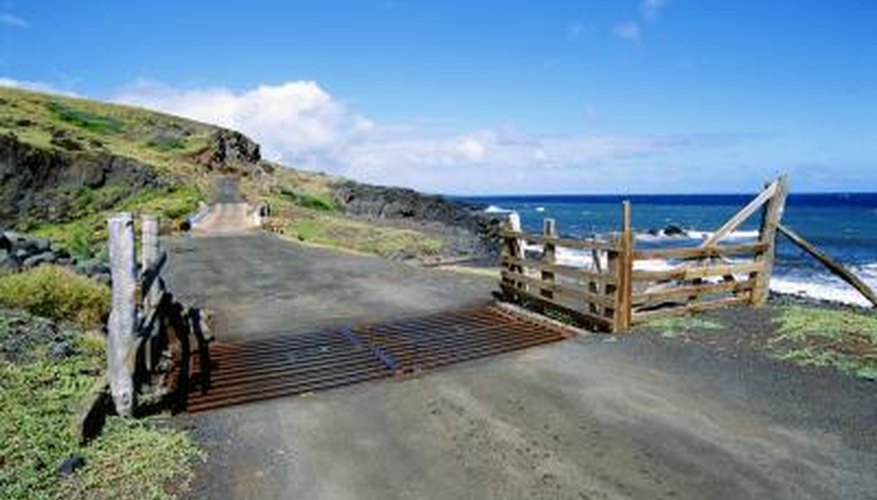Cattle grids, also known as cattle or stock grids, are composed of several parallel thick strips or tubes of metal suspended in a rectangular hole along the width of a road. Cattle grids are used to keep cattle, sheep and other livestock from leaving a particular area or from crossing into another area. For example, cattle grids are frequently used to keep livestock from crossing from private land over into public land.
How Cattle Grids Work
Cattle grids are usually sized to the width of the road and can be 6-12 feet long. Cattle grid metal tubes or bars that compose cattle grids are spaced far enough apart that when most livestock attempt to walk across cattle grids, the animal's feet fall through the spaces, trapping the animal. Frequently, however, livestock like cattle will not attempt crossing cattle grids for fear of falling. The metal tubes and bars are also close enough together that vehicles can travel across cattle grids without getting stuck.
- Cattle grids are usually sized to the width of the road and can be 6-12 feet long.
- Cattle grid metal tubes or bars that compose cattle grids are spaced far enough apart that when most livestock attempt to walk across cattle grids, the animal's feet fall through the spaces, trapping the animal.
Issues
When installing traditional cattle grids, there are some issues to be aware of. Very large bulls sometimes are not deterred by cattle grids. These bulls' hooves are so large that the bulls can walk across the cattle grid without getting trapped. Sheep have been known to walk along the side of cattle grids, or around them, thus avoiding the cattle grid spaces that would trap them. Deer can frequently jump the length of a 6- foot cattle grid. Cattle grids can also be expensive, costing £650 or more for a 10-foot-by-6-foot cattle grid, as of June 2011. There are several alternatives to cattle grids that address these issues.
- When installing traditional cattle grids, there are some issues to be aware of.
- These bulls' hooves are so large that the bulls can walk across the cattle grid without getting trapped.
Virtual Cattle Grids
Virtual cattle grids are simply several thick lines of paint applied across a road. These lines are created to resemble cattle grids, but are significantly less expensive than traditional cattle grids, and much easier to "install." Cattle are colour blind and have poor depth perception. As a result, when the cattle see a virtual cattle grid, they cannot tell that the spaces are not real and believe that if they step across the paint they will fall. Users have reported that particularly intelligent cattle are not necessarily deterred by virtual cattle grids.
- Virtual cattle grids are simply several thick lines of paint applied across a road.
- As a result, when the cattle see a virtual cattle grid, they cannot tell that the spaces are not real and believe that if they step across the paint they will fall.
Traditional Fencing
Traditional fencing keeps livestock in and many wild animals out. Though fences can be composed of stone or wood, many modern gates are composed of steel, which is durable and affordable. Some ranchers prefer wrought iron gates because wrought iron can be formed into fancy designs. Whatever material you choose, traditional fencing tends to be more expensive than cattle grids and cannot be installed across a highway or interstate.
- Traditional fencing keeps livestock in and many wild animals out.
- Whatever material you choose, traditional fencing tends to be more expensive than cattle grids and cannot be installed across a highway or interstate.
Electric Cattle Grids
Electric cattle grids are composed of metal wires stretched across the ground in the same pattern as a traditional cattle grid. These wires are attached to an electric fence so that when livestock touches the wires they receive a shock and will not continue to cross. Electric cattle grids can cost about £1,300 or less, depending on which materials you already own.
